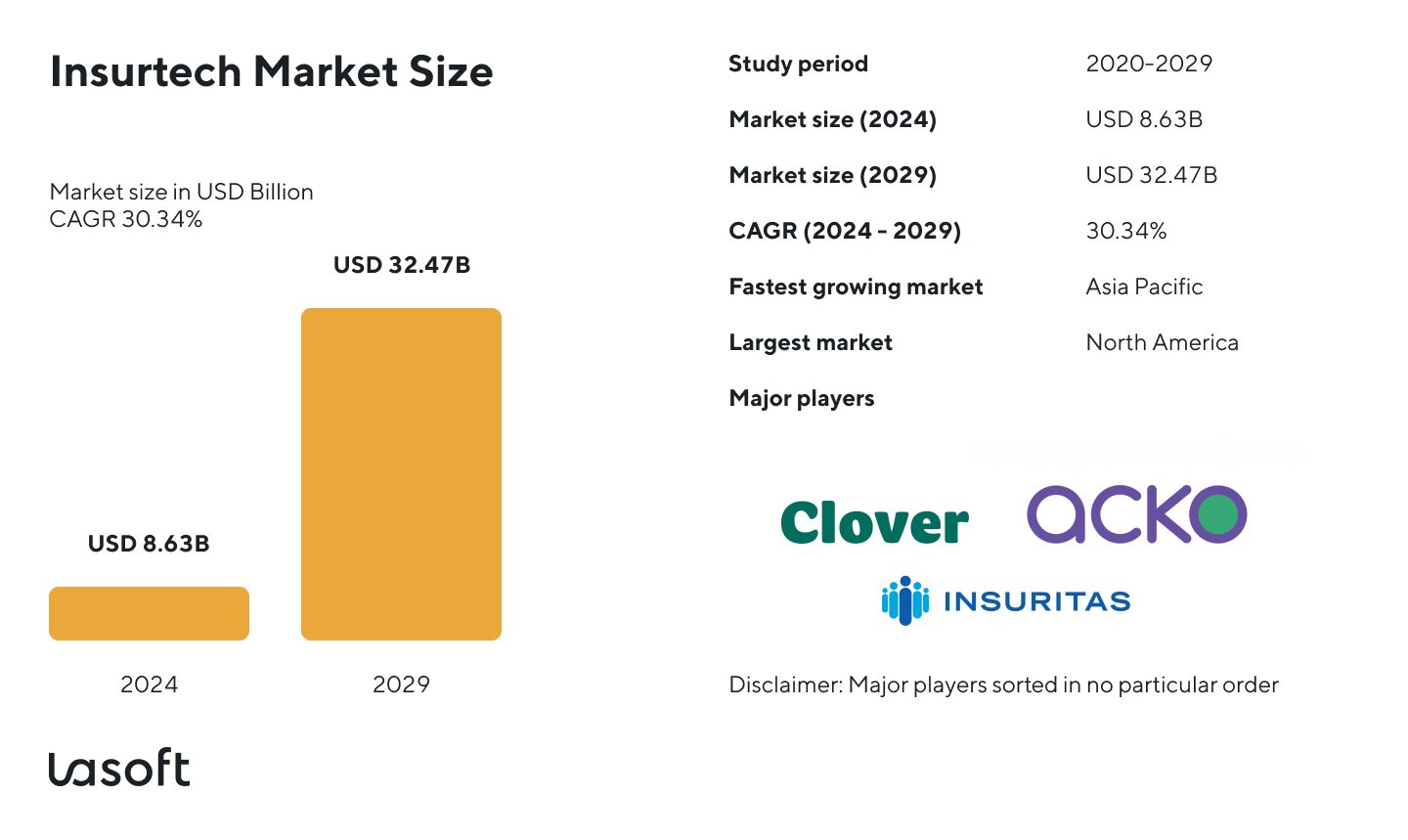Existential threats such as catastrophic climate risks, cybercrime, and annuity sector growth are prompting insurers to rethink their approach to engaging with potential clients, driving innovations insurance companies implement.
The insurance sector is eager to find the most effective ways to address the disruptions caused by these changing conditions, helping clients mitigate risk and prevent insured events rather than merely compensating for losses. Some extreme events may seem unavoidable, but risk assessments and proactive risk management try to minimize the impact on individual clients and companies affected by unforeseen situations.
Insurtech has gained popularity, offering businesses various benefits like risk mitigation, cost savings, cyber efficiency, risk management, and customer experience. Advanced technologies help insurtech products enter the competitive market with unique insurance solutions and navigate an increasingly complex and dynamic risk environment. Let’s delve into trends in the insurance industry to generate brilliant ideas for startups or large companies that can hit the market with innovative products and provide customer acquisition with unique offers.
Key takeaways:
- Innovations insurance companies implement amend the whole industry, moving from loss payout to risk prevention and mitigation, focusing on reducing the impact of catastrophic events, cybercrime, and market disruption.
- Digital drives the industry, IoT for real-time analytics, AI for fraud prevention, and mobile apps for 24/7 customer access.
- The cyber market is growing fast as cyber threats increase. Policies now cover data breaches, ransomware attacks, and third-party liabilities.
- Insurers are going green, buying green insurance products, and investing in renewable energy.
- AI-powered tools and machine learning models streamline claims processing, risk assessment, and underwriting, enabling faster and more accurate decision-making.
Growing Demand For Coverage
These days, the insurance market is increasingly focused on digital transformation, prioritizing a customer-centric approach, leveraging IoT for real-time data analytics, AI for fraud prevention, digitizing numerous processes, and enhancing many processes in our lives to protect customers’ peace.
The abundance of data, the growing need for data privacy, the expansion of cyber insurance, and changing regulatory frameworks all contribute to market growth. Companies implement insurtech solutions in underwriting, claims processing, risk assessment, and fraud detection.
Insurtech adoption varies across regions, with North America and Europe leading the market. The Asia-Pacific region, in contrast, shows significant growth potential due to a growing middle-class population seeking insurance.
The global insurtech market size is expected to expand at a compound annual growth rate (CAGR) of 30.34% from 2024 to 2029.

Source: Mordorintelligence
Innovations Insurance Industry Follows
As part of the financial services, the insurance industry invests in digital platforms that facilitate seamless communication between customers and insurance agents. These platforms offer an integrated, user-friendly interface, helping users get insurtech services from any device:
- easily obtain quotes,
- purchase underwrite policies,
- manage clients’ financial portfolios,
- assess risks,
- process claims,
- monitor underwrite policies performance.
Enhanced Customer Engagement with Mobile Apps
Mobile apps offer insurance services 24/7, so clients can manage their policies anytime, anywhere. This option is precious for anybody as it helps save time visiting the insurer’s office during business hours.
Mobile apps simplify the claims process:
- Submit claims directly through the app,
- Upload necessary documents, photos, and other evidence, speeding up the claims handling process,
- Get real-time updates on the status of the claim, enhancing transparency,
- Data analytics provide personalized insurance solutions and recommend policies that fit the user’s needs, lifestyle, and risk profile.
- Pay-as-you-drive auto insurance option. Such apps track driving behavior and adjust premiums accordingly, providing fairer pricing based on actual usage.
The Cyber Insurance Market Growth
The cyber insurance sector is projected to reach $14.8 billion by the end of 2024, up from an estimated $12.1 billion in 2023. Rising cyber threats and attacks have caused an enormous demand for cyber insurance coverage.
Cyber policies cover threats businesses face, such as data breaches and ransomware attacks. These policies are usually trendy among large corporations and industries with digital infrastructures that are highly vulnerable to cyber threats, especially in the finance and healthcare sectors.
Third-party coverage also played a significant role in the cyber insurance market. These policies cover liabilities and legal costs arising from breaches that affect customers and other parties’ data. The increase in data protection regulations, which bring the risk of lawsuits and fines, has led businesses handling sensitive customer data to invest more in third-party coverage.
Global Cyber Insurance Market
- 2024
- 14.8
- 2025
- 18.1
- 2026
- 22.1
- 2027
- 27.1
- 2028
- 33.1
- 2029
- 40.5
- 2030
- 49.5
Source: Market.US
Insurtech startups choose to follow a complex of strategies to enhance their value to businesses in the insurance market, helping to withstand rising cyber threats:
- Adjust insurance policies for insurance clients in specific industries, such as healthcare, finance, logistics, manufacturing, etc.
- Provide holistic risk management services, including cybersecurity assessments, incident response planning, and employee training, to help businesses proactively manage cyber risks.
- Partner with cybersecurity businesses to integrate capabilities like risk assessment services, threat intelligence, and incident response with 24/7 options.
Adopting Customer-Centric Business Model
Insurtech businesses introduce customer-centric business models, focusing on providing personalized insurance offerings. They use data analytics and customer insights to offer products and services adapted to meet personal needs. Personalization is the key player for any digital platform as it helps insurers enhance customer satisfaction, improve retention rates, and gain market share by engaging new loyal customers. Digital platforms and mobile apps support this shift towards customer-centricity and comfortable access to insurance services, like managing policies, getting insurance premiums, filing claims, and receiving customer support 24/7.
Advanced analytics outline insurers’ understanding of individual preferences by analyzing customer behavior, such as browsing patterns, purchase history, and claim activities. Usage-based insurance uses telematics and IoT devices to help track customer behavior, such as auto insurers’ driving habits or home security measures.
Artificial intelligence (AI) and machine learning technologies help with targeted marketing campaigns and personalized recommendations, segmenting customers based on demographics, behavior, and risk profiles. These features ensure that customers receive relevant information and offers.
Chatbots send personalized alerts and reminders on policy renewal dates or notifications about new products that may be of interest. How can chatbots and virtual assistants help your personalized customer services?
- Instant customer support.
- Answering queries.
- Guiding them through policy selection.
- Helping with claims filing.
Due to the highly competitive market, customers expect more from their insurance providers today. They demand seamless digital experiences and prefer personalized service and prompt support. Their interactions with tech-savvy industries shape these expectations, pushing insurance companies to innovate continuously and offer convenient insurtech products.
Usage-Based Insurance
Usage-based insurance (UBI) offers a fairer pricing model based on actual usage. For example, auto insurance adjusts premiums according to driving behavior. Different devices or mobile apps can track and monitor speed, braking, and mileage. UBI encourages safer driving habits and can lead to lower premiums for careful drivers.
Parametric Insurance
Parametric insurance is a coverage that pays out based on the occurrence of specific events rather than the actual loss incurred. For example, in a natural disaster case, the policy would pay a predetermined amount if certain conditions are met. This type of insurance allows for faster payouts and reduced administrative costs.
Environmental Sustainability
Insurers are adopting environmentally sustainable practices by offering green insurance products, investing in renewable energy projects, and implementing eco-friendly operations. These initiatives increase trust among environmentally conscious customers.
Predictive Analytics for Risk Assessment
Predictive analytics enables insurers to anticipate potential risks to take proactive measures. Historical data and identified patterns help predict certain events like natural disasters or health issues, allowing customers to prepare and mitigate risks.
Preventative Services
Insurers are increasingly offering preventative services to help customers avoid losses. These services can include home monitoring systems to prevent water damage, health programs to encourage wellness, and regular vehicle maintenance checks.
Brace for Blockchain Disruption
As a decentralized database system, blockchain provides secure signing, exchanging, and verification of transactions and records without a central authority. Blockchain technology is on the verge of dramatically disrupting the legacy systems in the insurance sector. The potential of this solution to improve transparency and security makes it highly appealing to use in many insurance operations. Blockchain technology simplifies handling claims by establishing a secure and unchangeable record of transactions, hence minimizing the chances of fraud and mistakes in administrative tasks.
In addition, blockchain-enabled smart contracts can automate the execution of policies and claim settlements, resulting in more dependable results. Traditional insurance companies are actively investigating the use of blockchain technology to create innovative business models and enhance current operational efficiency, positioning companies as insurance leaders.

Source: Mordorintelligence
Established insurance companies, innovative tech entrepreneurs (startups), and large digital corporations are the key participants in the blockchain insurance industry. Blockchain insurance covers property and casualty, life and health, and reinsurance. Blockchain technology has been developed in both established and developing areas and has been implemented on public, consortium, and private blockchains.

Source: GA
AI & Automation for Faster Claims Processing
Many industries implement artificial intelligence (AI) and automation technologies. The insurance industry is no exception. It uses AI to streamline the claims process, significantly improving efficiency and customer satisfaction.
AI-powered systems automatically process claims, reducing the time from submission to settlement. These systems help analyze data, verify information, assess damage, and prevent fraud through AI algorithms; insurers can handle claims faster than traditional methods.
Automation provides real-time data analysis from various sources, including photos, videos, and sensor data. These features allow insurers to assess the extent of damage and make quick decisions on claim approvals, speeding up the entire process.
Automation minimizes the risk of human error in data entry and evaluation procedures, leading to more accurate claim assessments. Insurers use predictive analytics to assess the likelihood of specific claims and their potential cost to set more accurate reserves and pricing.
Artificial Intelligence in Insurance, Market Size 2024-2030
- 2024
- 8.13
- 2025
- 10.81
- 2026
- 14.39
- 2027
- 19.15
- 2028
- 25.48
- 2029
- 33.9
- 2030
- 45.11
Source: Precedence research
Rapidly Rising Machine Learning Adoption
Artificial intelligence and machine learning are closely related technologies that are often used interchangeably. Still, they have different applications in the insurance industry. What is the key differences between AI and ML in the context of the insurance industry?
| Artificial Intelligence (AI):
AI systems can perform tasks requiring human intelligence, such as reasoning, learning, problem-solving, perception, and understanding different languages. AI encompasses many technologies and techniques, including ML, natural language processing (NLP), computer vision, and robotics for business processes. |
Machine learning (ML):
ML is a subfield of AI that focuses on developing algorithms and models that help systems learn from data and make predictions to gain insights. Machine learning models are trained on large data sets without requiring explicit programming to recognize patterns and increase their accuracy over time. |
AI Applications:
|
ML Applications:
|
| AI Decision-Making:
AI systems can make decisions based on complex criteria and rules, often incorporating multiple AI techniques, including ML, to achieve the desired outcome. AI systems can be rule-based or adaptive and can adjust to new data. |
ML Learning and Adaptation:
ML models learn from data inputs and improve over time. They can be trained using supervised learning (with labeled data), unsupervised learning (without labeled data), or reinforcement learning (learning from the consequences of actions). ML models adapt as they are exposed to more data, becoming more accurate in their predictions and decisions. |
AI in Insurance Use Cases Examples:
|
ML in Insurance Use Cases Examples:
|
Expanding Innovation in Insurance Digital Services
Rapidly changing consumer preferences and advanced technologies drive the shift toward digital transformation in all industries. The insurance industry increasingly uses digital channels and services to reach and engage customers.
Access to Services With Online Platforms and Mobile Apps:
These digital channels give clients 24/7 online access to insurance services, enhancing the overall customer experience.
Digital Sales and Marketing:
Insurers use digital channels and Generative AI to market their products and reach a broader audience. Online platforms allow for targeted advertising and personalized marketing campaigns, increasing brand value and elevating customer experiences.
Health Insurance Innovations:
Digital channels like telehealth and virtual consultations have become increasingly important for health insurers. These services provide customers with remote access to healthcare providers, enhancing convenience and reducing costs.
Digital Wellness Programs:
Insurance companies offer digital wellness programs through mobile apps and online platforms. These programs provide health tips, fitness tracking, and personalized health plans, encouraging healthy lifestyles and preventive care.
Social Media and Content Marketing Improve Brand Engagement:
SMM helps with brand engagement and customer interaction. Insurers use social media platforms to share informative content, answer customer questions, and build brand loyalty.
Integrated Customer Journey:
An omni-channel approach integrates various digital channels, providing customers with a consistent experience across all touchpoints. This integration ensures that customers can interact with their insurers through their preferred channels, whether online, via mobile apps, or through social media.
Data Integration:
Digital channels enable customer data integration across different platforms, providing insurers with a comprehensive view of each customer’s interactions and preferences. This data-driven approach enhances personalized service and supports better decision-making when developing business strategies.
Embedded Insurance
When we speak about embedded insurance, we mean the integration of insurance coverage directly when purchasing products or services, providing automatic policy sales options as part of their overall transaction. This approach solidifies consumer interest and simplifies obtaining insurance by making it a natural part of the buying experience.
Embedded Insurance Use Cases
- Travel Tours and Airline Insurance: When booking flights or vacation packages, customers can also choose travel insurance that covers trip cancellations, flight delays, and medical emergencies.
- Auto Insurance: Car dealers and manufacturers may include insurance in the vehicle purchase or lease agreement.
- Gadget Insurance: Retailers selling electronics, such as smartphones or laptops, also offer to buy policies to cover damage, theft, or loss.
- E-commerce Platforms: Online marketplaces can allow buyers to add insurance for shipping protection or product warranties during checkout.
Final Insights
Innovations insurance companies embrace are transforming the industry, and customer-focused business models address the changing risks and market challenges. IoT, AI, blockchain, and innovative insurtech solutions are changing how insurers operate, making them more efficient and customer-centric.
The focus is shifting towards insured event prevention, real-time risk management, and personalization so insurers can stay relevant in a fast-changing and complex global market. This is a great opportunity for start-ups and established players to redefine insurance services and meet the modern customer’s needs.
If you want to know more about LaSoft’s expertise in developing software solutions for our clients in the insurance industry, check our portfolio.
FAQ
What is the usage analytics dashboard?
Customer-Centric Models: Personalized services, data collection, and the use of data analytics to meet customer needs better transform the insurance industry and outline the insurance leader.
Digital Transformation: Mobile apps and online platforms offer services with 24/7 access to insurance management and claims.
What is the biggest challenge facing the insurance industry?
Integrate new technologies to remain competitive.
Manage increasing cybersecurity threats.
Meet customer expectations for digital and personalized services.
What is an InsurTech company?
Is insurance in a hard market right now?
Higher premiums.
Stricter underwriting criteria.
Fewer policies are available. Factors such as increased claims, natural disasters, and economic uncertainties are contributing to these conditions.


